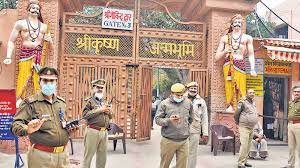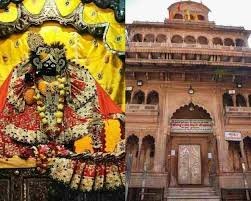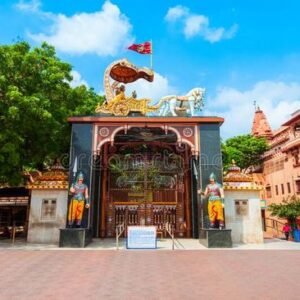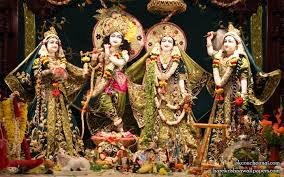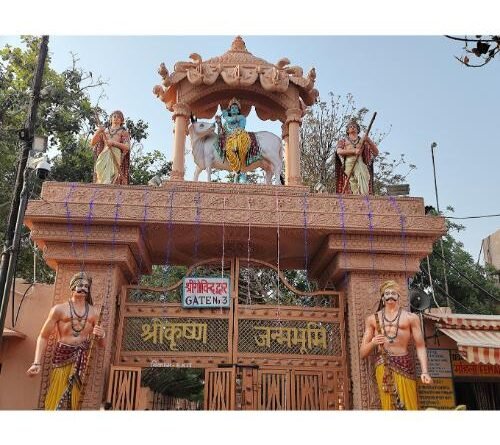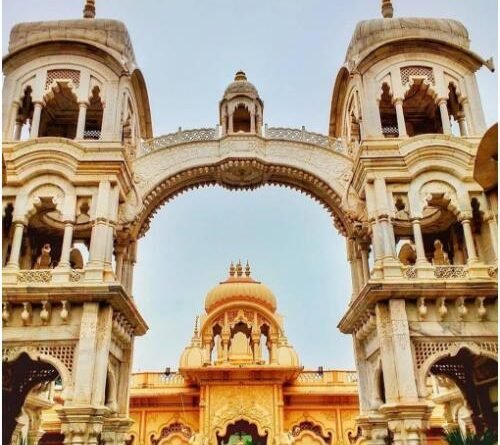Krishna Janmabhoomi Temple Mathura,Uttar Pradesh
The Krishna Janmasthan Temple Complex is a group of Hindu temples in Mallapura, Mathura, Uttar Pradesh, India. These temples are built at the location where the Hindu deity Krishna is believed to be born, and is adjacent to the Shahi Eidgah mosque built by Aurangzeb.
The place has held religious significance since the 6th century BC. The temples were destroyed multiple times throughout history, most recently by the Mughal emperor Aurangzeb in 1670. He built the Eidgah mosque there which still stands. In 20th century, the new temple complex adjacent the mosque was built with the financial help from industrialists containing the Keshavdeva temple, the Garbha Griha temple at the birthplace and the Bhagavata Bhavan.
According to Hindu traditions, Krishna was born to Devaki and Vasudeva in a prison cell where they were confined by his maternal uncle Kansa, a king of Mathura, due to prophecy of his death by the child of Devaki. According to tradition, a temple dedicated to Krishna was built the birthplace by his great grandson Vajranabh.The present site known as Krishna Janmasthan (lit. ’birthplace of Krishna’) was known as Katra (lit. ’market place’) Keshavdeva.
In 1017 or 1018, Mahmud of Ghazni attacked and plundered Mahaban. Ghazni’s scribe, though not accompanying him on the expedition, Al Utbi describes in his Tarikh-i-Yamini neighbouring holy town which is identified as Mathura.He wrote, “In the centre of the city there was a huge and magnificent temple, which the people believed wasn’t built by men but by the angels… Any description of the temple, either in words or in pictures, would fall short and fail to convey its beauty.” Mahmud of Ghazni wrote, “if any one wished to construct a building equal to it, he would not be able to do so without spending a hundred million dinars, and the work would occupy two hundred years, even though the most able and experienced workmen were employed.” He ordered to burn all the temples and demolish them. He plundered gold and silver idols and carried away a load of hundred camels.A stone inscription in Sanskrit found from the site mentions that in Vikram Samvat 1207 (1150) a person named Jajja who may have been a vassal of Gahadavala king built a Vishnu temple which was ‘brilliantly white and touching the clouds’.
Mathura came under British control in 1804. The East India Company auctioned the land of Katra and it was purchased by Raja Patnimal, a wealthy banker of Banaras. Raja Patnimal wanted to build the temple but could not do so. His descendants inherited the land of Katra. His descendant Rai Krishna Das was challenged, for the ownership of 13.37 acres of land on which the shrine and the Shahi Eidgah is situated, in two civil suits by the Muslims of Mathura but the Allahabad High Court ruled in favour of Raj Krishna Das in both suits in 1935. Kailash Nath Katju and Madanmohan Chaturvedi had helped in these lawsuits. Politician and educationist Madan Mohan Malaviya acquired the land from Raj Krishna Das on 7 February 1944 at the cost of Rs. 13000 with financial help of Industrialist Jugal Kishore Birla Following death of Malaviya, Jugal Kishore Birla formed a trust named Shri Krishna Janmabhoomi Trust, later registered as the Shri Krishna Janmasthan Seva Sansthan, on 21 February 1951 and acquired the land.Jugal Kishore Birla entrusted the construction of the new temple with another industrialist and philanthropist Jaidayal Dalmia.
In 1968, the Shree Krishna Janmasthan Seva Sangh and the Shahi Eidgah committee reached a compromise agreement which granted the temple land to the Trust and the management of the Shahi Eidgah to the Eidgah committee as well no legal claim of the Shree Krishna Janmasthan Seva Sangh on the Shahi Eidgah. Indian National Congress leader Ganesh Vasudev Mavalankar was the first chairman of the Shree Krishna Janmasthan Seva Sangh which signed the compromise agreement and his legal authority to sign agreement is contested. He was succeeded by M. A. Ayyangar, followed by Akhandananda Saraswati and Ramdev Maharaj. Nrityagopaldas is the present chairman. Following the demolition of the Babri Mosque in 1992, Manohar Lal Sharma, a resident of Vrindavan, has filed a petition in the Mathura District Court challenging the 1968 agreement as well as a petition to quash the Places of Religious Worship Act of 1991 which preserves the status quo as on 15 August 1947 for all places of worship.
There is a large and deep stepped water tank, Potra Kund or Pavitra Kund, in south-east of the Janmasthan temple which is said to have been used for the first bath of child Krishna after his birth.The steps of the tank were built by Mahadji Scindia in 1782. They were restored by his descendants in 1850.












